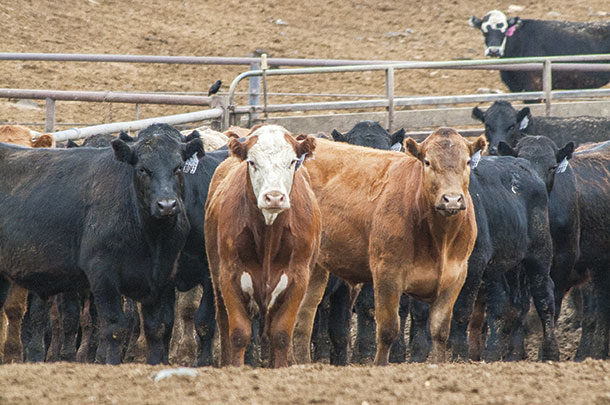While all ages of cattle from young calves to yearlings and cows are affected by bacterial pneumonias, interstitial pneumonia, the lesser- known cousin, usually waits to attack either pasture or feedlot cattle that are changing feed sources or are well on their way to finishing.
This somewhat mysterious affliction is a real and serious threat, but hard facts on the disease are lacking. In the late 1970s, veterinarians at the University of Guelph, Ontario, Canada, noted that pathologists had observed cattle with the disease for several years. Cases as early as 1962 were documented and later considered the same disease.
Facts and characteristics
Atypical interstitial pneumonia (AIP), or acute bovine pulmonary emphysema and edema, is an acute respiratory disease that continues to plague the beef industry by affecting mostly adult beef cattle either grazing lush pastures through late summer and fall or feedlot cattle nearing the finishing stage. Also known as fog fever, acute bovine respiratory distress syndrome and bovine asthma, it produces what many areas of the world refer to as “panters” or “lungers,” due to the unmistakable noises they often make.
Dr. Ron Clarke of the Western Canadian Association of Bovine Practioners has some specific ideas about the characteristics of the disease. For pasture cattle moving from mature or dry conditions into lush green forage, he sees the culprit being the lushness combined with the abrupt change, not the actual forage species. “AIP appears to be associated with elevated acidity of the rumen [a rumen PH greater than 6],” says Clarke.
For feedlot cattle, he explains that scientists feel AIP could be caused by certain chemicals being produced in the rumen, traveling through the bloodstream to the lungs and causing an allergic, shock-type response. He also believes that most cattle dying of AIP in feedlots have pre-existing lung disease caused by common respiratory pathogens.
Other potential causes are airborne dust that appear during the warmth of spring from moldy feed and the topical straw of winter bedding material breaking down.
Targets and results
Bacterial pneumonias affect all types of animals, but most cases deal with the weaker and more challenged. AIP in the feedlot is much more specific and often targets the better-quality animals in the herd. Jerry Bohn, general manager at Pratt Feeders, Kansas, says, “It appears to show up in the high-quality, high-performing, big-eating cattle. Those with the best genetics seem to be the most susceptible, usually toward the end of the feeding period.” He adds that the higher the on-feed performance, the more AIP there usually is. Rates of infection are also three to four times higher in heifers than in steers, but studies continue to try to understand why this is the case.
While not as plentiful as bacterial pneumonias, a study by J.A. Valles of Kansas State University in 2013 reported that 3.1% of all cattle placed in a feedlot environment tend to develop acute interstitial pneumonia. It specifically noted rapid effects, frequently with death occurring within a 24-hour period after the onset of the disease.
Post-mortem results typically show congested and fluid-filled lungs with a smooth, wet, rubbery, checkerboard appearance. In the chambers where air exchange normally takes place, fluid and large gas-filled bubbles occupy interstitial spaces.
Timing and symptoms
It is important for feedlot pen checkers to actively guard against interstitial pneumonia due to the minimal buffer of time that exists before treatment must occur. Basic signs of the disease are slightly gaunt animals with quick, uneven breathing, standing apart from the group. As symptoms advance and worsen, cattle will stand with feet spread apart, extended necks and lowered heads. The most serious cases will display hard, open-mouth breathing, often with salivation and froth dripping to the ground. Emerald green stools may be noticed throughout the pen.
Pen checkers will often hear these animals before they see them. Loud expiratory grunting or rattling noises may be displayed. Coughing is usually not symptomatic of interstitial pneumonia. At times, afflicted cattle will develop emphysematous crackles as air from the thorax migrates under the skin. “Some cattle have subcutaneous emphysema or air under the skin extending from the withers along the entire back,” says Clarke.
Treatments and prognosis
Treatment for the disease is often ineffective. Some studies appear to show that feeding higher levels of ionophores like monensin may reduce the incidence of AIP. Diuretics and anti-inflammatories with antibiotics may also be beneficial. “No specific treatment regiment for AIP exists at this time,” says Clarke.
Interstitial pneumonia hits with such speed and power that time and lung capacity for the animal are extremely limited. Stressful and extensive exercise on the trip to the treatment facility must be avoided. A large percentage of medium to severe cases will end in collapse and death if the animals are moved too forcefully. If affected cattle can be treated on-site with a short-period withdrawal drug such as ceftiofur hydrochloride plus an anti-inflammatory, there is a better success rate. At times, the only option may be to offer shade and comfort where the animal is located. Individuals will either recover or die over the course of the next day or two.
Cattle in early stages of the disease displaying only mild signs will often recover spontaneously within several days, but severely affected animals face an uphill struggle to recovery. A study by Dr. P.H. Mapham, BVSc, and Dr. J.H. Vorster, BVSc, both of South Africa, found that in general, 30% of cattle clinically affected with AIP will die, regardless of treatment.
While recognizing atypical or acute interstitial pneumonia is easier than treating it, it is important for pen checkers to be aware of the timing and condition of cattle on feed in the yards. Afflicted animals can be handled and treated with some success if the disease is caught early enough. Waiting too long will only offer a quick slaughter option at best, providing longer-term withdrawal treatment drugs have not been used. ![]()
PHOTO: While recognizing atypical or acute interstitial pneumonia is easier than treating it, it is important for pen checkers to be aware of the timing and condition of cattle on feed in the yards. Staff photo.
Bruce Derksen is a freelance writer from Lacombe, Alberta, Canada. Email Bruce Derksen.









